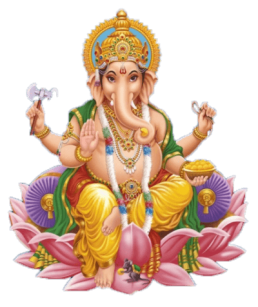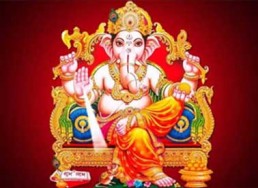Agajanana Padmakam
अनेकदंतं भक्तानाम् एकदन्तम्-उपास्महे ॥१॥
anekadaṃtaṃ bhaktānām ekadantam-upāsmahe ..1..
(Or)
As the rays from the lotus-face of Gauri (Devi Parvati) is always on her beloved son Gajanana (Who has the face of an elephant), similarly, the Grace of Sri Ganesha is always on his devotees; granting their many prayers; the devotees who with deep devotion worship the ekadanta (one with a single tusk).

Description
Excerpt from the book ‘Prayer Guide’ by Swami Dayananda Saraswati
Gajananam ekadantam aharnisam upasmahe. Gaja is elephant and anana means face. Gajanana is one who has the face of an elephant. Ekadanta is the one who has only one danta, tusk. Upasmahe means we meditate upon and aharnisam means day and night. We meditate day and night upon that one who has the face of an elephant, and who has one tusk.
Agajanana-padmarkam is a compound word. That which is born is jah, jayate iti jah. Gah means that which goes, gacchati iti gah. Agah means that which does not move, na gacchati iti agah, parvata, mountain. The king of the mountain is parvata-raja. Agat jayate, then, is the one who is born of aga, the mountain king. This is Goddess Parvati. Parvati is called Agaja, Girija. In this context agajananam is agajayah ananam, the face of Goddess Parvati. This face of Parvati is likened to the lotus, padma, agajananam eva padmam.
For a lotus to bloom, the presence of the sun is required. While the water-lily blooms in the wake of moon at night, the water-lotus blooms only when the sun is up. Arka means sun. So too Parvati’s lotus like face requires a sun to bloom, and this is Lord Ganesa. He is the one who is the sun, as it were, for the lotus that is the face of Goddess Parvati. When she sees Lord Ganesa, she is so happy that her face blossoms. Lord Ganesa is himself gajanana, who has the face of an elephant which is a symbol for all wisdom and all power.
What is anekadantam? It is anekadam tam. The one who gives is dah, dadati iti dah. The one who gives ekam, one thing, is called ekadah, ekam dadati iti ekadah. Lord Ganesa is not the giver of only one thing. He is anekadah, the giver of all that you want; in the second case-ending, it is anekadam. He gives aneka: dharma, artha, kama, and moksha. You can get everything by his grace. Tam means him. Anekadam tam means unto that Lord whose grace will help you achieve everything. For whom is he anekadah?
Bhaktanam, for his devotees, those who invoke him. We meditate upon this Lord Ganesa.
Other Ganesha Shlokams
Gajananam Bhuta
I bow to you, the Lord with the face of an elephant (Gajanana), one who is served by the celestial attendants (Bhoota ganas) and other beings. The one who consumes the extract of Kapitha (wood apple)
Gananamtva Ganapatim
Among the celestial attendants (Ganas), you are the Lord (Ganapathi), We offer sacrificial oblations to you You are the wisest among the scholars. Your wisdom is known to be highest quality and uncomp
Ganapathi Atharvashirsha
The Ganapati Atharvasirsha Upanishad is a Sanskrit text and a minor Upanishad of Hinduism. It is a late Upanishadic text dedicated to Ganesha, the deity representing intellect.
Ganapati Stotram
As the rays from the lotus-face of Gauri (Devi Parvati) is always on her beloved son Gajanana (Who has the face of an Elephant), Similarly, the grace of Sri Ganesha is always on his devotees; Granting
Ganesh Chathurthi
Significance of Ganesh Puja, Vinayaka Chavithi or Chathurthi. See how to prepare for Ganesha Pooja, How to perform the Puja with Video instructions and enjoy Audio devotional songs, uninterrupted and without ads.
Ganesha Gayatri Mantra
We pray to the one-tusked; we meditate on the one having a twisted trunk. May that Ganapati (one-tusked) inspire us (to meditate).
Ganesha Pancharathnam
The composer, Guru Sri Adi Shankaracharya had praised the God Ganesha by presenting these five stanzas as five jewels, hence the name Maha Ganesha Pancharatnam.
Ganesha Stavah
Ganesha Stavah or Ganapati Stavah is a set of 13 verses that describe the glory of Lord Ganesha. Gaṇapati stavaḥ is said to be from Ganesh Purana - upāsanā khaṇḍa adhyāya 13.
Mooshika Vahana
Salutations to Sri Vighna Vinayaka, whose vehicle is the mouse and who has the modaka in his hand, whose large ears are like fans and who wears a long sacred thread, who is short in stature and is th
Sankata Nashana Ganesha Stotram
This stotram is from Narada Purana. Sankata means problems, difficulties and Nashanam means to destroy. So, by chanting this stotram one is praying to Lord Ganesha to remove his difficulties. In Sanskrit, English Translation, Meaning, Significance…
Shuklambaradharam
I meditate upon (Lord Ganesa), the one who wears a white garment, who is all-pervasive, who has a (bright) complexion like the moon, who has four hands, who has a cheerful face, for the removal of all
Vakratunda Mahakaya
O god with the twisted trunk, broad-bodied, brilliant as thousand suns, bless me with freedom from obstructions and hindrances in all my works and for all times.
Agajanana Padmakam – Ganesha – With commentary by Swami Dayananda


